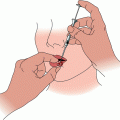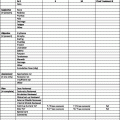Outcome
Stage I (N = 24) (%)
Stage II (N = 16) (%)
All patients (%)
p-Value
Local control
96
87
92
0.3240
Regional control
87
65
78
0.1587
Local-regional control
87
67
79
0.1607
Distant metastasis-free survival
71
37
57
0.0073
Cause-specific survival
58
27
45
0.0090
Overall survival
48
18
36
0.0037
Fang et al. reported on 50 patients treated at the University of Washington between 1985 and 2007 for microscopically positive (26 patients) or macroscopically positive (24 patients) nodes [15]. The 2-year regional control rates for 26 patients with microscopically positive SLNBs were 100 % whether the patients were treated with RT alone (19 patients) or neck dissection with or without RT (7 patients). The median follow-up for this subset of patients was 18 months (range, 5–62 months). The 2-year regional control rates for those with macroscopically positive nodes were 78 % after RT alone (9 patients) compared with 73 % after surgery alone or combined with RT (15 patients) (p = 0.8). The median follow-up was 16 months (range, 5–109 months). The authors concluded that RT alone results in equivalent regional control compared with surgery alone or combined with RT for patients with positive regional nodes. Caveats pertaining to this study are that selection bias could have impacted outcomes, the number of patients is relatively small, and the follow-up is short.
Veness and co-workers reported on an unfavorable series of 43 patients treated at Westmead Hospital (21 patients) and Royal Brisbane/Mater Hospital (22 patients) between 1993 and 2007 with RT alone for medically or technically inoperable MCC [17]. RT was delivered at initial diagnosis in 24 patients (56 %) and for recurrence in the remainder (usually nodal recurrence in a previously untreated nodal basin). The median maximum tumor diameter was 3 cm (range, 0.5–13 cm). The median follow-up was 39 months (range, 4–78 months). The median RT dose to the primary lesion was 51 Gy; the median RT dose to the nodes was 50 Gy. The median dose per fraction was 2 Gy. Recurrence developed in 60 % of patients; 15 (35 %) of 45 patients recurred outside of the RT fields. The in-field control rate was 75 % and the 5-year overall survival rate was 37 %. Interesting points regarding this study are that the in-field control and 5-year survival rates are surprisingly favorable after relatively modest dose RT in an unfavorable series of patients.
Foote et al. reported on 112 patients treated with curative intent RT between 2000 and 2005 at three public radiotherapy treatment centers in Queensland, Australia [18]. Nine patients were treated for recurrent MCC and 103 patients were previously untreated. RT was delivered to the primary site in 88 % of patients for gross (11 %) or subclinical (78 %) disease and to the regional nodes in 89 % of patients, mostly for subclinical disease (71 %). Gross nodal disease was treated with RT in 19 % of patients. The likelihood of failure in the clinically negative regional nodes was 33 % for those who did not receive elective nodal irradiation (ENI), which was significantly higher than for those who did receive ENI. The likelihood of in-field disease control was higher for those who received ≥50 Gy for subclinical disease and ≥55 Gy for gross disease.
Clark and colleagues reported on 110 patients with head and neck MCC treated at Princess Margaret Hospital (Toronto), Westmead Hospital (Sydney), and the Royal Prince Alfred Hospital (Sydney) with either surgery or RT (44 patients) or combined surgery and adjuvant RT (66 patients); survivors had a mean follow-up of 2.3 years [19]. The 5-year local control rate was 84 %; the 5-year regional control rate was 69 %. Surgery and adjuvant RT resulted in improved local control (p = 0.009) and regional control (p = 0.006) compared with single modality therapy. The 5-year cause-specific and overall survival rates were 62 % and 49 %, respectively. Combined modality treatment resulted in improved disease-free survival (p = 0.013) compared with single modality therapy.
Mojica et al. reported on 1,665 patients included in the SEER database from 1973 to 2002; 1,487 patients (89 %) received surgery as a component of their therapy [7]. Adjuvant RT was administered to approximately 40 % of the surgically treated patients and was associated with a significant improvement in median survival compared with surgery alone (63 months vs. 45 months, p = 0.0002).
Poulsen and co-workers reported on 40 patients with high-risk MCC who received adjuvant chemotherapy according to the Trans-Tasman Radiation Oncology Group TROG 96:07 study from 1997 to 2001 [11]. Patients had ≥1 of the following high-risk factors: recurrent disease, positive nodes, primary tumor size >1 cm, and gross residual disease after surgery. The primary site and regional nodes received 50 Gy/25 fractions/5 weeks and patients received concomitant carboplatin (AUC 4.5) and etoposide 80 mg/m2




Stay updated, free articles. Join our Telegram channel

Full access? Get Clinical Tree





